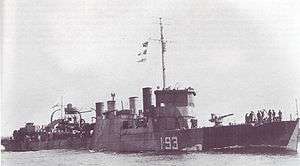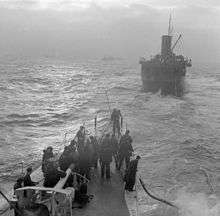USS Bancroft (DD-256)
 As HMCS St. Francis during the Second World War | |
| History | |
|---|---|
| Name: | USS Bancroft |
| Namesake: | George Bancroft |
| Builder: | Bethlehem Shipbuilding Corporation, Fore River Shipyard, Quincy |
| Cost: | $1,218,962.89 (hull and machinery)[1] |
| Laid down: | 4 November 1918 |
| Launched: | 21 March 1919 |
| Commissioned: | 30 June 1919 |
| Decommissioned: | 24 September 1940 |
| Struck: | 8 January 1941 |
| Identification: | DD-256 |
| Fate: | Transferred to Canada, 24 September 1940 |
| Name: | HMCS St. Francis |
| Namesake: | St. Francis River |
| Commissioned: | 24 September 1940 |
| Decommissioned: | 1945 |
| Honours and awards: | Atlantic 1941-43 |
| Fate: | declared surplus 1 April 1945. sank July 1945 off Cape Cod, Massachusetts, en route to scrapping. |
| General characteristics | |
| Class & type: | Clemson-class destroyer |
| Displacement: | 1,216 tons |
| Length: | 314 ft 4 in (95.81 m) |
| Beam: | 31 ft 8 in (9.65 m) |
| Draft: | 9 ft 10 in (3.00 m) |
| Propulsion: |
|
| Speed: | 35 knots (65 km/h) |
| Range: | 4,900 nautical miles (9,100 km) at 15 knots (28 km/h) |
| Complement: | 122 officers and enlisted |
| Armament: |
|
The second USS Bancroft (DD-256) was a Clemson-class destroyer in the United States Navy, and transferred to the Royal Canadian Navy, where she served as HMCS St. Francis during World War II.
As USS Bancroft
Named for George Bancroft, she was launched 21 March 1919 by Bethlehem Shipbuilding Corporation's Fore River Shipyard in Quincy, Massachusetts, sponsored by Miss Mary W. Bancroft, great granddaughter of George Bancroft; and commissioned 30 June 1919, Lieutenant Commander H. S. Haislip in command.
Bancroft joined the Atlantic Fleet and took part in fleet training activities until 26 November 1919 when she went into reserve commission. She was placed out of commission at Philadelphia 11 July 1922.
Bancroft was recommissioned 18 December 1939 and served with the Atlantic Squadron on the east coast until decommissioned at Halifax, Nova Scotia, and transferred to Great Britain in the destroyer-land bases exchange 24 September 1940.
As HMCS St. Francis

Bancroft was allocated to the Royal Canadian Navy and was taken over by the Canadians 24 September 1940. Following the Canadian practice of naming destroyers after Canadian rivers (but with deference to the U.S. origin), St. Francis was named after the St. Francis River forming the border between northern Maine and Quebec and New Brunswick.[2] St. Francis left Halifax 15 January 1941 and arrived in the River Clyde, Scotland, 26 January. She joined the 4th Escort Group and on 20 May she rescued all the survivors of the steamship Starcrose which had to be sunk after being torpedoed by a submarine. At the end of June she escorted a troop convoy to the Middle East and in July she joined the newly formed Newfoundland Escort Force. Between 1941 and 1943 St. Francis made several attacks on enemy submarines while escorting convoys ON-95, SC-85, ON-105, HX-197, and ON-116 with Mid-Ocean Escort Force group C-4.[3] St. Francis subsequently escorted convoy ON-121 with Escort Group C-3, convoy SC-99 with Escort Group C-1, and convoy ON-147 with Escort Group C-4.[4]
After refitting at Halifax, St. Francis joined Escort Group C.2 in the Western Approaches Command in June 1943 but in August was transferred to the 9th Escort Group (RCN), working from Londonderry Port, Northern Ireland. She returned to the Western Local Escort Force at Halifax the following month. From early 1944 she was employed on training duties at Digby, Nova Scotia, where on 1 April 1945 she was declared surplus.
On her way to Baltimore to be scrapped by the Boston Iron & Metal Co. in July 1945, she sank as a result of a collision off Cape Cod, Massachusetts.[5]
Trans-Atlantic convoys escorted
| Convoy | Escort Group | Dates | Notes |
|---|---|---|---|
| SC 49 | 14-21 Oct 1941[6] | Newfoundland to Iceland | |
| SC 55 | 19-25 Nov 1941[6] | Newfoundland to Iceland | |
| SC 71 | 27 Feb-9 March 1942[6] | Newfoundland to Northern Ireland | |
| ON 76 | 16–23 March 1942[7] | Northern Ireland to Newfoundland | |
| SC 78 | 9–16 April 1942[6] | Newfoundland to Northern Ireland | |
| ON 90 | 5–9 May 1942[7] | Northern Ireland to Newfoundland | |
| SC 85 | MOEF group C4 | 31 May-12 June 1942[6] | Newfoundland to Northern Ireland |
| ON 105 | MOEF group C4 | 20–27 June 1942[7] | Northern Ireland to Newfoundland |
| HX 197 | MOEF group C4 | 9–16 July 1942[8] | Newfoundland to Northern Ireland |
| ON 116 | MOEF group C4 | 26 July-1 Aug 1942[7] | Northern Ireland to Newfoundland |
| ON 121 | MOEF group C3 | 20-22 Aug 1942[7] | Iceland to Newfoundland |
| SC 99 | MOEF group C1 | 9-19 Sept 1942[6] | Newfoundland to Northern Ireland |
| ON 147 | MOEF group C4 | 20-23 Nov 1942[7] | Northern Ireland to Newfoundland |
| ON 146 | MOEF group B3 | 29 Nov-5 Dec 1942[7] | Northern Ireland to Newfoundland |
| SC 127 | WLEF | 16–20 April 1943[6] | Halifax to Newfoundland |
| ONS 4 | WLEF | 29 April-5 May 1943[7] | Newfoundland to Halifax |
| HX 240 | WLEF | 21–25 May 1943[8] | Halifax to Newfoundland |
| HX 242 | MOEF group C2 | 6–14 June 1943[8] | Newfoundland to Northern Ireland |
| ON 190 | MOEF group C2 | 25 June-1 July 1943[7] | Northern Ireland to Newfoundland |
| ONS 19 | 9th escort group | 27 Sept-9 Oct 1943[7] |
Notes
- ↑ "Table 21 - Ships on Navy List June 30, 1919". Congressional Serial Set (U.S. Government Printing Office): 762. 1921.
- ↑ Milner 1985 p.23
- ↑ Milner 1985 p.286
- ↑ Milner 1985 pp.285-9
- ↑ "Bancroft (Destroyer) ii". Dictionary of American Naval Fighting Ships. Retrieved 31 January 2015.
- 1 2 3 4 5 6 7 "SC convoys". Andrew Hague Convoy Database. Retrieved 2011-06-19.
- 1 2 3 4 5 6 7 8 9 10 "ON convoys". Andrew Hague Convoy Database. Retrieved 2011-06-19.
- 1 2 3 "HX convoys". Andrew Hague Convoy Database. Retrieved 2011-06-19.
References
- This article incorporates text from the public domain Dictionary of American Naval Fighting Ships. The entry can be found here.
- Milner, Marc (1985). North Atlantic Run. Naval Institute Press. ISBN 0-87021-450-0.
External links
| ||||||||||||||||||||||||||||||||||||